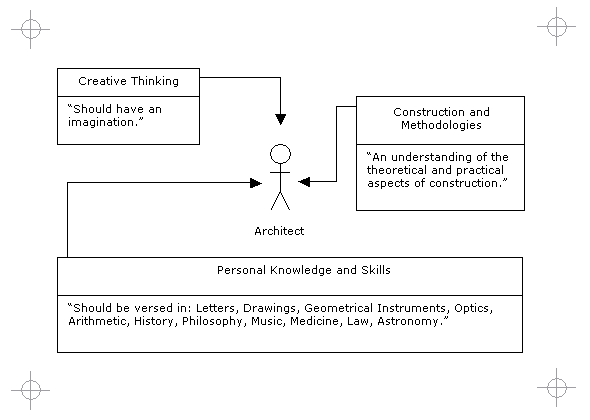|
Diagram
|
|
|

|
|
Title
|
|
|
Vitruvian Architect
|
|
Building Architecture
|
|
|
Vitruvius defined a set of attributes for what constituted an architect. This definition of the architect has been the cornerstone of architecture education and training down to the modern period.
|
|
Architecture Intensive Disciplines
|
|
|
A software architect should be creative or have the ability to think creatively. Architecture in information technology involves a great deal of abstract thinking and the ability to conceptualise mental models. Architects need to have both theoretical and practical knowledge of software and systems construction, the software development life-cycle and methodologies. As individuals, they should value knowledge in other fields and have a wide range of interests. Personal learning and growth is the essence of the architect. System patterns can be found in other aspects of life and in other disciplines such as medicine (health care), law, music, history etc.
|
|
Case Study A: Large Corporate IT
|
|
|

|
|
|
After having been exposed to software architecture based on visual patterns, frameworks and models, many of those that were mentored recognised that the terms "architect" and "architecture" were applied incorrectly and too closely to platform and vendor specific definitions. It rarely went deeper than the buzzwords used by sales people selling products or tools. As with many organisations, the title "architect" and the term "architecture" has become fashionable - even an over used label. If the Vitruvian definition of an architect were to be applied in this case, many would either not be considered as an architect by their peers or will re-consider their own position.
Perhaps one of the most common short-comings is the lack of creative thinking and theoretical understanding. Some lack the broader understanding or experience of the complete development life cycle. There are many IT developers that do not have an understanding of methodologies nor of the software development life cycle itself. Of greater concern are those who do not see the relevance. Lastly, few take the time to balance their life and interests. As a knowledge centered discipline, reading and research is essential.
Apart from the way architects abstract and think, they must also demonstrate an ability to model. Like project managers without project plans, one must be weary of so-called architects who cannot conceptualise and lack visualisation skills. Some members of the team were exposed to other corporate environments and shared their own experiences of "architects". Some of the worst presentations that members of the team had commented on came from so-called "architects". Prior to this experience, some had a negative perception of architecture and had commented on how different the approach was and how it balanced theory and practice. One of the best outcomes of this case are the individuals who have decided to either study further or pursue the profession of software architecture.
|
|
Case Study B: Small Commercial Team
|
|
|

|
|
|
The small technical team, management and members of staff had not only understood the relevance of architecture but also understood the role of the architect. Even though, the role had not been previously introduced, the company's development experience had made the lack of architecture notable.
|
|
|


